Issue Archive
Table of Contents
BLOOD COMMENTARIES
PLENARY PAPER
Clonal hematopoiesis landscape in frequent blood donors
Transfusion services rely on healthy donors, some of whom donate frequently over many years. In this Plenary Paper, Karpova et al leveraged a unique cohort of older male donors with over 100 lifetime donations and demonstrated that, while the rate of clonal hematopoiesis (CH) is highly similar between frequent donors and low-frequency donor controls, specific types of DNMT3A mutations were detected across all lineages, showing distinct responses to erythropoietin (EPO). This finding is notable, as transient increases in EPO expression are a well-documented consequence of blood donation. It is reassuring that frequent blood donation does not appear to increase CH; however, further studies should explore whether EPO preferentially promotes expansion of hematopoietic stem cells carrying certain DNMT3A mutations.
REVIEW ARTICLE
Advances in RNA editing in hematopoiesis and associated malignancies
Adenosine-to-inosine RNA editing is a posttranscriptional modification mediated by adenosine deaminase acting on RNA (ADAR) enzymes that converts adenosines to inosines in both coding and noncoding RNA transcripts, thereby influencing the function of a wide range of RNAs. Pu et al provide a comprehensive review of recent studies showing a crucial role for this process in hematopoietic cell development and hematologic malignancy progression. The authors also explore the therapeutic potential of targeting ADAR expression and specific RNA substrates.
HOW I TREAT
How I approach pharmacological thromboprophylaxis in children
Over the past 2 decades, the incidence of venous thromboembolism (VTE) in children has increased. Sochet and colleagues review current approaches to pediatric VTE thromboprophylaxis in specific populations, illustrating their recommendations through 4 patient case examples. The authors describe their evidence-informed, subpopulation- and setting-specific approaches to pharmacological thromboprophylaxis and highlight the need for future pediatric trials to better inform VTE prevention strategies for children.
CLINICAL TRIALS AND OBSERVATIONS
Up-front blinatumomab improves MRD clearance and outcome in adult Ph– B-lineage ALL: the GIMEMA LAL2317 phase 2 study
Clinical Trials & Observations
Several recent pivotal trials have shown the benefit of adding blinatumomab to induction chemotherapy in adult and pediatric acute lymphoblastic leukemia (ALL). Bassan and colleagues report on a prospective phase 2 study consisting of a chemotherapy-blinatumomab sequence for untreated adult patients with Philadelphia chromosome-negative (Ph–) CD19+ B-lineage ALL and found that administration of blinatumomab following chemotherapy resulted in an increase in minimal residual disease (MRD) negativity from 72% to 93%. This study confirms the benefit of incorporating blinatumomab into induction regimens for the treatment of MRD-positive disease, although further improvement is needed for higher-risk patients who exhibit early MRD persistence.
Blitzing ALL with blinatumomab
Clinical Trials & Observations
IMMUNOBIOLOGY AND IMMUNOTHERAPY
Integrative genomic analysis of DLBCL identifies immune environments associated with bispecific antibody response
Although immunotherapies benefit many patients with relapsed diffuse large B-cell lymphoma (DLBCL), the majority still experience disease progression, highlighting the need to better understand how the immune environment influences treatment response. Tumuluru et al applied a multiomic approach to large, independent datasets and identified 4 DLBCL immune quadrants based on immune-related and cell-of-origin signatures. In therapy-specific analyses, the authors found that patients with germinal center B-cell-like (GCB) “hot” DLBCLs exhibited superior progression-free survival with bispecific antibody therapy compared to those with GCB “cold” DLBCLs. While these clinical findings require validation in additional cohorts, this study supports the concept that the pretreatment immune environment influences the effectiveness of immunotherapies.
LYMPHOID NEOPLASIA
Dual biological role and clinical impact of de novo chromatin activation in chronic lymphocytic leukemia
Previous studies have shown that chronic lymphocytic leukemia (CLL) cells exhibit a de novo chromatin activation pattern compared to normal B cells. Chapaprieta and coauthors investigated the clinical relevance of this observation and found that regulatory regions undergoing de novo chromatin activation in CLL were associated with both progressive and indolent disease. The authors identified that a balance score between proprogression and proindolence chromatin signatures served as a powerful, independent prognostic factor in CLL and outperformed immunoglobulin heavy chain variable gene mutational status. However, translating these findings into routine practice will require adaptation of research assays for clinical use and further validation.
MYELOID NEOPLASIA
A CEBPB/IL-1β/TNF-α feedback loop drives drug resistance to venetoclax and MDM2 inhibitors in monocytic leukemia
Resistance to BCL2 and MDM2 inhibitors such as venetoclax and idasanutlin is common in acute myeloid leukemia (AML) cells of the monocytic lineage. Allen et al provide insights into the mechanisms of resistance, describing a positive feedback loop involving interleukin-1 (IL-1)/tumor necrosis factor alpha (TNF-α)/NF-κB pathway members regulated by CEBPB, which promotes monocytic differentiation and confers drug resistance. These findings suggest that AML therapy could potentially be improved by testing strategies aimed at suppressing inflammatory cytokines and key transcription factors.
THROMBOSIS AND HEMOSTASIS
Integrated cross-linking by TG2 and FXIII generates hepatoprotective fibrin(ogen) deposits in injured liver
Fibrinogen has hepatoprotective and prorepair effects in the acutely injured liver. Wei et al investigated the roles of factor XIII (FXIII) and tissue transglutaminase (TG2), capable of introducing cross-links into substrates that involve distinct glutamine and lysine side chains. The authors show that TG2 drove unique in vitro fibrin cross-linking with thrombin-activated FXIII, thus providing hepatoprotective effects in acute liver injury.
TRANSPLANTATION
HLA-haploidentical stem cell transplantation for chronic granulomatous disease: an EBMT-IEWP retrospective study
Clinical Trials & Observations
LETTER TO BLOOD
Lymphoid malignancies in patients with Shwachman-Diamond syndrome
Clinical Trials & Observations
BLOOD WORK
-
Cover Image
Cover Image
![issue cover]()
Multispectral immunofluorescence image showing PAX5+ lymphoma cells (green), CD8+ T cells (red), and CD4+ T cells (blue) in “inflamed” or hot diffuse large B-cell lymphoma. See the article by Tumuluru et al on page 2460.
- PDF Icon Front MatterFront Matter
- PDF Icon Table of ContentsTable of Contents
- PDF Icon Editorial BoardEditorial Board
Advertisement intended for health care professionals
Email alerts
Advertisement intended for health care professionals


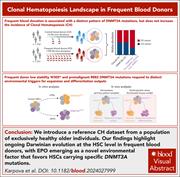
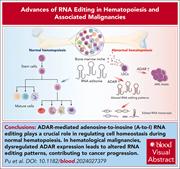
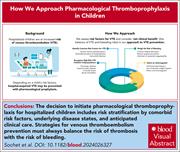
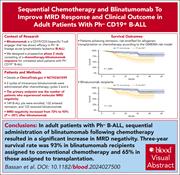
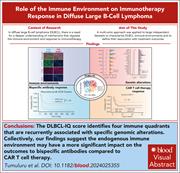




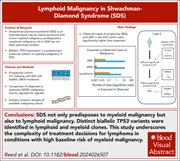

Of donors and dynamics